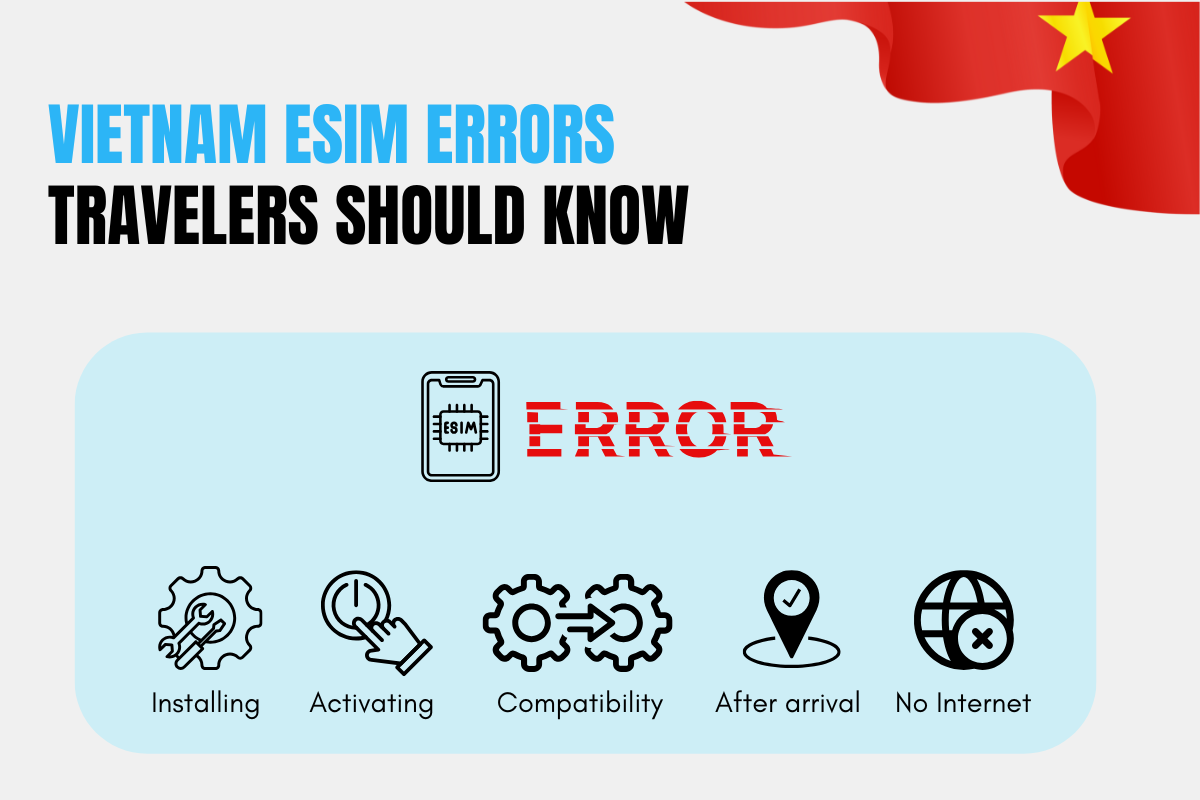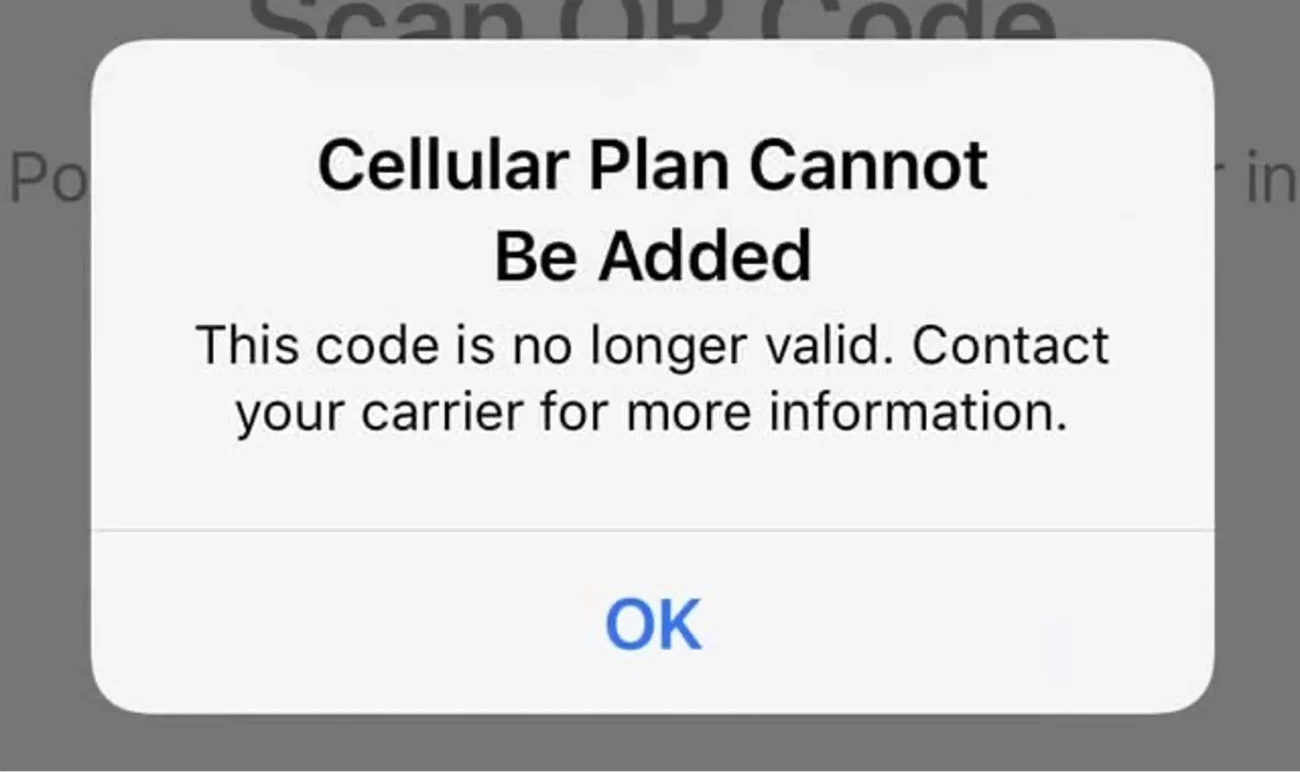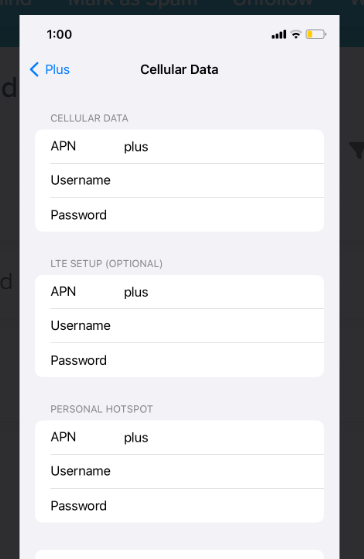eSIMs are a popular choice for travelers visiting Vietnam due to their convenience and quick activation. However, some users may encounter unique challenges, especially with Vietnam-specific activation methods. This guide will cover the most common Vietnam eSIM errors and provide solutions to ensure a smooth experience.

I. Common Vietnam eSIM Errors and How to Fix Them
1. Activation Issues
Activation problems are among the most common challenges travelers face with eSIMs.
1.1. QR Code Scanning Problems
Cause: Issues like blurry QR codes, poor lighting, or outdated phone software.
Solution: Ensure you’re in a well-lit area, clean your camera lens, and retry scanning. If the issue persists, manually enter the activation code provided by the eSIM provider.

1.2. Device Incompatibility
Cause: Some phones don’t support eSIM technology, or the device may be locked to a specific carrier.
Solution: Before purchasing, check if your device supports eSIMs and is carrier-unlocked. Most modern smartphones, such as newer iPhones and Samsung Galaxy models, are compatible.
1.3. SMS Activation Requirement (Vietnam-Specific)
Cause: Some Vietnam eSIM providers require sending an SMS to activate the eSIM plan, which can be problematic if your home SIM is not active or doesn’t allow international SMS.
Solution: Choose an eSIM provider like vietnamesim.com that offers hassle-free activation without requiring SMS. If your provider requires SMS, ensure your home SIM is active, or temporarily use a local SIM for activation.
2. Incorrect Device Settings
Improper settings can prevent the eSIM from functioning properly.
2.1. eSIM Not Set as Default Data Plan
Cause: The phone defaults to the physical SIM for data usage.
Solution: Go to your phone’s settings and set the eSIM as the default data plan to ensure uninterrupted internet access.
2.2. APN (Access Point Name) Settings Not Configured
Cause: Missing or incorrect APN settings can block data connectivity.
Solution: Follow the APN setup instructions provided by your eSIM provider. Many providers, including vietnamesim.com, include these details in their setup guides.

3. eSIM Not Working After Arrival in Vietnam
Sometimes, eSIMs fail to connect upon arrival in Vietnam.
3.1. Roaming Settings Not Enabled
- Cause: Roaming settings are disabled, preventing the eSIM from connecting to local networks.
- Solution: Enable roaming for the eSIM in your phone’s settings before arrival.
3.2. Delayed Activation
- Cause: The eSIM wasn’t activated before leaving your home country.
- Solution: Always activate the eSIM and test it before traveling to Vietnam.
3.3. Manual Network Selection Required
- Cause: Automatic network selection may fail in some areas.
- Solution: Manually select a recommended network, such as Viettel or Vinaphone, in your phone’s mobile network settings.
► Read more: Get more details about top Vietnam mobile networks
4. Limited or No Internet Connectivity
Connectivity issues can disrupt your travel plans if not addressed immediately.
4.1. Data Plan Exhausted
- Cause: Exceeding the data limit of your plan.
- Solution: Monitor your data usage through your phone settings and purchase additional data if required.
4.2. Weak Signal in Remote Areas
- Cause: Poor network coverage in rural or mountainous regions.
- Solution: Move to an area with stronger coverage or contact your provider for recommendations.
4.3. Network Configuration Issues
- Cause: Temporary glitches or misconfigured network settings.
- Solution: Reset your phone’s network settings and restart the device.
5. Incompatibility with Dual-SIM Usage
Using an eSIM alongside a physical SIM can sometimes create conflicts.
5.1. Conflicts Between Physical SIM and eSIM
- Cause: Both SIMs being active can cause conflicts with data and calling preferences.
- Solution: Prioritize the eSIM for data usage and disable mobile data on the physical SIM.
5.2. Incorrect Default SIM for Calls or Messages
- Cause: The phone defaults to the physical SIM for calls or texts.
- Solution: Go to your phone’s SIM management settings and set the eSIM as the default for calls, texts, or data.
II. How Often Do Vietnam eSIM Errors Happen?
While eSIM errors are relatively rare, they can occur due to technical issues, device settings, or provider-specific quirks like SMS activation. For most travelers, these issues happen in less than 10% of cases.
What Increases the Risk?
- Using an unsupported or locked device.
- Not activating the eSIM in advance.
- Choosing an unreliable eSIM provider.
Why Errors Are Less Likely with Reliable Providers:
Providers like vietnamesim.com have user-friendly activation processes, clear instructions, and responsive customer support, significantly reducing the likelihood of issues.
III. How to Avoid Common eSIM Errors in Vietnam
- Verify Compatibility: Ensure your phone supports eSIMs and is unlocked.
- Choose the Right Provider: Opt for a provider that offers clear instructions and has dedicated customer support 24/7.
- Activate in Advance: Activate and test your eSIM before traveling to Vietnam.
- Save Support Details: Keep your provider’s customer support contact information handy for troubleshooting.
